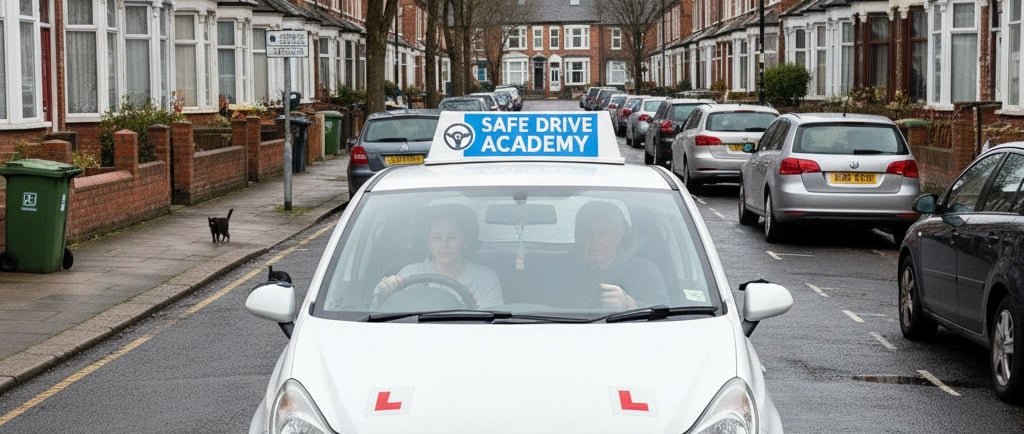How Many Driving Lessons Do I Need in Chingford & Loughton? A Realistic Guide for Learners
Not sure how many driving lessons you need in Chingford or Loughton? Discover realistic lesson hours, what affects them, and how to know if you’re test‑ready.
11/17/20255 min read


How Many Driving Lessons Do I Need in Chingford & Loughton?
If you’re learning to drive around Chingford or Loughton, you’ve probably asked yourself:
“How many driving lessons do I actually need before I can pass?”
Friends might say they passed in 10 or 15 lessons. Driving schools might quote averages. The DVSA has its own guidance. It’s confusing.
This guide pulls everything together so you get a clear, realistic answer for learners using Chingford driving test centre and practising on local roads.
The Short Answer
For most learners in this area:
First‑time learners
Plan for around 35–50 hours of professional driving lessons.Learners who have already failed a test once
Often need another 5–10 hours of focused lessons to correct mistakes and rebuild confidence.
This is a realistic planning range for Chingford/Loughton – not a guarantee, but a good starting point.
What the DVSA Says
The DVSA (which sets the UK driving test) says the average learner needs:
About 45 hours of professional lessons, plus
Around 22 hours of private practice with family or friends.
Most reputable UK driving schools quote something similar.
In busy, complex areas like Chingford and Loughton, many learners end up near the middle to higher end of this range because of the roads and traffic conditions.
Why Chingford & Loughton Can Take More Lessons
Learning to drive around Chingford/Loughton isn’t the same as learning in a quiet village. You’ll be dealing with:
Tight residential roads packed with parked cars
Mini‑roundabouts and awkward junctions where position and priority really matter
One‑way roads and side streets that punish poor observation
Busy high streets and school areas, especially at peak times
Access to faster roads like the A406 North Circular, which require:
Confident joining and leaving
Good mirror use and lane discipline
Clear judgement at higher speeds
You’re not just learning to control a car; you’re learning to think ahead, manage pressure, and make safe decisions in real London traffic. That takes time and practice.
What Changes How Many Lessons You Need?
1. Your Confidence and Learning Speed
You may need fewer lessons if you:
Feel calm behind the wheel
Pick up coordination quickly (steering, pedals, gears)
Make decisions confidently at junctions and mini‑roundabouts
You may need more lessons if you:
Feel very nervous or anxious
Freeze when other drivers are close behind you
Struggle to judge gaps and priorities
Nervous learners often take longer to feel comfortable on:
Narrow streets with parked cars
Busy Chingford/Loughton junctions
The A406 and other higher‑speed roads
That’s normal – it just means your hour count may be towards the upper end of the range.
2. How Often You Take Lessons
Your progress depends a lot on consistency:
One 2‑hour lesson per week
A very effective pattern. You get enough time each session to warm up, learn something new, and practise it properly.One 1‑hour lesson per week
Progress is slower. You may spend much of the hour recapping what you did last time.Irregular lessons (big gaps)
You forget more, so you end up needing more total hours even if you think you’re saving money by spacing lessons out.
If you want to keep your overall hours reasonable, commit to regular lessons, ideally in 2‑hour blocks.
3. Private Practice with Family or Friends
Private practice can be a big help – or a big problem.
It helps if:
Your supervising driver follows the same routines your instructor teaches (mirror‑signal‑manoeuvre, correct positioning, proper speed).
You drive on a mix of local roads: quiet estates, slightly busier routes, and different times of day.
It harms if:
Your supervisor says things like “Ignore what the instructor says, do it this way.”
You practise speeding, rushing decisions, rolling stops, or not using mirrors.
Good practice can reduce the number of professional hours you need. Bad practice can increase them because your instructor has to undo bad habits first.
What “Test‑Ready” Looks Like at Chingford
Instead of focusing on a magic number of lessons, ask:
“Could I realistically pass the test at Chingford if it was tomorrow?”
Most good instructors would say you’re close to test‑ready when you can:
Drive for 35–40 minutes on a mix of local roads with minimal help from your instructor.
Deal with tight streets and oncoming traffic around parked cars without panicking or hitting the kerb.
Handle mini‑roundabouts and one‑way streets confidently, choosing the correct lanes and priorities.
Join, drive on, and leave faster roads like the A406 safely, maintaining good lane discipline and speed control.
Complete all the manoeuvres (bay parking, parallel parking, pulling up on the right, etc.) smoothly, even if you feel under pressure.
Cope with busy times (school runs, rush hour) without your driving falling apart.
Follow verbal directions or sat‑nav while still giving proper attention to mirrors, signs, and hazards.
If you can’t yet do these things reliably, you probably need more lessons – even if your lesson count is already high.
Typical Lesson Ranges for Different Learners
Here’s a realistic guide for learners in Chingford/Loughton:
1. Confident First‑Time Learner (With Practice)
You learn quickly, stay calm, and get regular private practice.
You might reach test standard in around 30–40 hours of professional lessons.
2. Average First‑Time Learner
You mainly learn with an instructor, maybe with a bit of extra practice.
Normal nerves, normal progress, nothing extreme.
Expect something like 35–50 hours.
3. Nervous or Anxious Learner
You feel tense in traffic, on roundabouts, or at higher speeds.
You need more time to build trust in yourself and other road users.
You may need 45–60+ hours to become truly safe and confident, depending on how regular your lessons are.
4. Learner Who Has Already Failed a Test
If your driving is still fairly fresh and you failed recently:
Many learners need around 5–10 extra hours of focused lessons to:
Fix the reasons for failing
Practise test‑style routes
Build confidence and test technique
If you took a long break after failing, you might need more time again to get back to standard.
Why Rushing Usually Costs More
Trying to “pass quickly with minimum lessons” is a common goal – but it often backfires:
You book a test before you’re ready.
You fail (possibly more than once).
You pay for more lessons, more test fees, and go through more stress.
In the end, you may spend more money and more time than if you had planned a realistic number of lessons from the beginning.
It’s better to aim to be safe and confident than to just scrape through a test.
How to Get a Personal Answer for Yourself
You don’t have to guess. Do three things:
Ask your instructor directly
“Realistically, how many more hours do you think I need?”
“What’s stopping me from being test‑ready right now?”
Request a mock test
A proper 35–40 minute mock on local routes around Chingford will show whether you’re close or not.
If your instructor has to talk constantly, you’re not ready yet.
Be honest about your nerves
If certain roads, speeds, or situations scare you, you’ll probably need extra practice there.
That’s not failure – it’s part of becoming a safe driver.
A Practical Planning Guide for Chingford & Loughton
To plan your time and budget, use this as a realistic guide:
First‑time learner
Plan for around 35–50 hours of professional driving lessons.Already failed once
Plan for around 5–10 extra hours of focused lessons to fix weaknesses and get your confidence back.
Then adjust up or down based on:
Your confidence
Lesson frequency
Private practice
Feedback from your instructor
Remember: you’re not just learning to pass at Chingford test centre. You’re learning to drive safely in real traffic, on real roads, for the rest of your life.
If that takes a few extra hours, it’s worth it.
